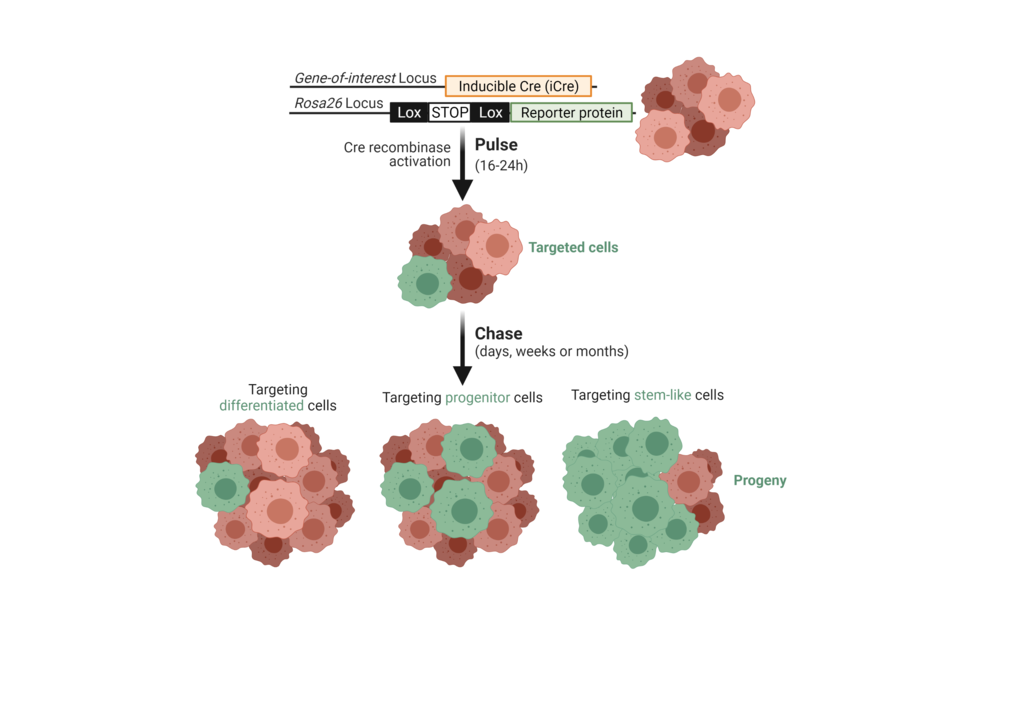OVERVIEW
Our laboratory studies the key signals governing stem cell and cell fate specification during malignant progression and the mechanisms by which different signaling pathways control cell plasticity in cancer. Specifically, we use in vivo lineage tracing, live imaging, cytometry and expression profile analysis as experimental tools to achieve our goals. Our group combines murine transgenic models, patient-derived xenografts and 3D organoids to unravel cellular hierarchies within tumors, to gain a better understanding of cancer heterogeneity and drug resistance.
OUR RESEARCH
Cancer is a heterogeneous disease with a cellular hierarchical organization that is largely unexplored in many tumor subtypes. Moreover, in some cases hierarchical relationships among stem cells, progenitors and differentiated cells remain unsolved due to the high degree of cellular plasticity, which allows cells to switch between different cellular stages.


OUR GOALS
We are a newly created group passionate about cellular hierarchies and tumor heterogeneity. Our main lines of research and specific goals are:
1. To illustrate cellular hierarchies within tumors. We use a well-established hierarchical model to study multipotency in tumors. Now, we are separately monitoring three mammary epithelial compartments to measure the presence of multipotency within breast tumors. Our hypothesis is that breast tumors are indeed sustained by different subpopulations, which self-maintain independently
2. To discover cytotoxic agents for specific cellular subpopulations. A therapy based on a combination of several drugs to target different cellular populations could eradicate primary tumors, thereby preventing relapse and metastasis. We want to screen for natural compounds that selectively kill specific subsets of cells that are responsible for tumor maintenance and/or intrinsically resistant to current therapies.
3. To target the tumor niche to prevent the spread of cancer. One of our main objectives is to generate in vivo tools that will allow us to study new therapeutic targets to prevent relapses in hematological cancer. To that end, our lab works on different strategies, which include murine and human models, to test a panel of drugs currently used as a standard of care for non-Hodgkin’s lymphoma (NHL) and explore the role of senescence in tumors cells, as well as in their microenvironment.
Our ultimate mission is to understand the tumor heterogeneity between different patients with a view to improving their treatment of choice by searching for novel and personalized therapeutic strategies.
OUR CHALLENGES
We hope to answer the following questions through our research:
1. How can cellular plasticity improve treatment for cancer patients?
2. Can we achieve truly personalized medicine by identifying single or combinatorial therapies to target different cellular populations at the same time?
3. Can we prevent metastasis and/or relapses by targeting the most frequently colonized tissues?
Selected Publications
Current Grants
2024 BENES 00052
Agència de gestió d'ajuts universitaris i de recerca
CURA Cuidemos la Investigación: Unión para potenciar la Resiliencia mediante el Acompañamiento
Fundació internacional josep carreras
Improving lymphoma outcomes by neutralizing chemotherapy-induced endothelial damage
PID2023-150280OB-I00
Ministerio de ciencia, innovación y universidades
LiLum Desentrañando el papel del linaje luminal en la progresión tumoral del cáncer de mama triple negativo
Janémateu foundation
Eliminación de células senescentes en linfoma no-Hodgkin: Una estrategia combinada para prevenir recaídas
CNS2024-154693
Ministerio de ciencia, innovación y universidades
LIPSTiC Utilización de la identidad celular para la estratificación de pacientes y desarrollo de terapias dirigidas en el cáncer de mama Triple Negativo





